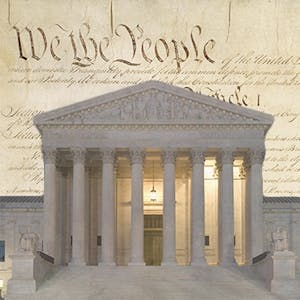Chemerinsky on Constitutional Law - The Structure of Government
This course will highlight the construction and interpretation of the U.S. Constitution through the centuries. You’ll learn the history behind the Constitution, cases that formed important precedent, and how changes in interpretation have been dependent on shifts in cultural and political climate as well as the composition of the Supreme Court.We’ll start with an overview of the Constitution where we’ll consider questions such as “Why the Constitution?” and “What function does the Constitution serve?” Next we’ll examine how the Constitution and its subsequent interpretation established the powers of the federal, legislative, and judicial branches of government and allocated powers to the states.
Join me as we look at the questions both raised and answered by the Constitution and those that interpret it!
By the end of this course, you should be able to:
Describe how the structure of the United States government has been shaped by both the text of the Constitution and by subsequent interpretation and practice of political actors in all branches of government
Illustrate compromises found in the Constitution by citing examples and historic background
Articulate the importance of key cases such as Marbury v. Madison, McCullough v. Maryland, and Lochner v. New York
Explain how the outcome of cases is often dependent upon the current cultural and political climate as well as the composition of the court by citing particular cases and important shifts in the court’s jurisprudence
Assess the relative suitability of various approaches to constitutional interpretation and analysis
None
Syllabus
Syllabus - What you will learn from this course
Week 1
Welcome - Let’s Get Started
Lecture 1 - Why the Constitution?
Week 2
Lecture 2 - The Federal Judicial Power
Week 3
Lecture 3 - The Federal Legislative Power
Week 4
Lecture 4 - The Federal Executive Power
Week 5
Lecture 5 - Federalism
Conclusion
FAQ
When will I have access to the lectures and assignments?
Access to lectures and assignments depends on your type of enrollment. If you take a course in audit mode, you will be able to see most course materials for free. To access graded assignments and to earn a Certificate, you will need to purchase the Certificate experience, during or after your audit. If you don't see the audit option:
The course may not offer an audit option. You can try a Free Trial instead, or apply for Financial Aid.
The course may offer 'Full Course, No Certificate' instead. This option lets you see all course materials, submit required assessments, and get a final grade. This also means that you will not be able to purchase a Certificate experience.
What will I get if I purchase the Certificate?
When you purchase a Certificate you get access to all course materials, including graded assignments. Upon completing the course, your electronic Certificate will be added to your Accomplishments page - from there, you can print your Certificate or add it to your LinkedIn profile. If you only want to read and view the course content, you can audit the course for free.
Is financial aid available?
Yes. In select learning programs, you can apply for financial aid or a scholarship if you can’t afford the enrollment fee. If fin aid or scholarship is available for your learning program selection, you’ll find a link to apply on the description page.
Reviews
while this is a good course, if your are a middle/high school student the assignments will be very difficult and the lectures will be hard to understand.
Chermerinsky's classes were the best that I have taken. Very interactive and the fellow students really participated which made the class worth attending.
My only regret regrading this course is that the discussion about Bill of Rights is not the part of the same session. Other than that, it's been superb.
i learned a lot about the constitution through this class and i am looking forward to taking part two.
